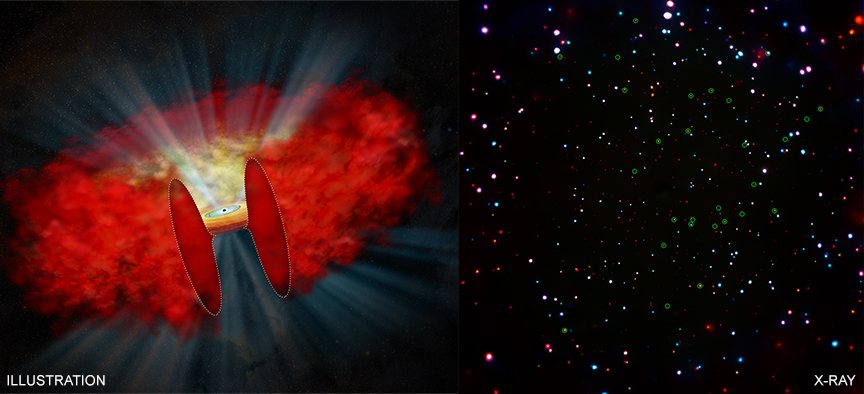Mistaken identity? Researchers uncover true nature of monster black holes
Over two dozen supermassive black holes have been uncovered.
Over two dozen misidentified supermassive black holes have finally been revealed in a new, sky-scanning study.
A team of researchers led by Erini Lambrides of Johns Hopkins University (JHU) in Baltimore, Maryland has spotted 28 supermassive black holes that have been masquerading as other cosmic objects using a host of telescopes including NASA's Chandra X-ray Observatory, Hubble Space Telescope and Spitzer Space Telescope. The team observed these black holes which lie 5 billion light-years or more away within the Chandra Deep Field-South (CDF-S), the deepest X-ray image ever taken.
"With our new identifications we've found a bunch of heavily obscured black holes that had previously been missed," Lambrides said in a statement. "We like to say we found these giant black holes, but they were really there all along."
Related: The strangest black holes in the universe

Scientists had already identified 67 growing black holes within this image, obscured by "cocoons" or surrounding envelopes of dust and gas. Now, with this new study, researchers have identified these 28 supermassive black holes, which were previously miscategorized as either slowly growing black holes with low-densities or without cocoons or distant galaxies, according to a statement.
"This could be considered a case of mistaken black hole identity," co-author Marco Chiaberge of Space Telescope Science Institute in Baltimore, Maryland, said in the statement. "But these black holes are exceptionally good at hiding exactly what they are."
With these new observations, these objects were found to actually be supermassive black holes, the largest type of black hole, which grow by pulling in surrounding material with their intense gravitational pull. Material sucked in by the black hole heats up and emits radiation in a wide variety of wavelengths, including X-rays — hence why X-ray telescopes are so helpful in observing these far-off objects.
Get the Space.com Newsletter
Breaking space news, the latest updates on rocket launches, skywatching events and more!
To come to this conclusion, Lambridges and her team compared their data with what is expected for a growing black hole and predicted the amount of X-rays they should expect from each object. They found a much lower level of X-rays than they anticipated from these 28 X-ray sources. This led them to find that the cocoon of gas and dust surrounding the objects is about 10 times denser than previously estimated.
Taking this higher-density cocoon into account, the team was able to show how these black holes produce more X-rays than previously thought, as the cocoon stops a large amount of X-rays from escaping and being observed from Earth. As these cocoons feed growing black holes, finding that these cocoons are much denser than expected led the researchers to find that the black holes are growing quickly as they are fueled by these surrounding envelopes.
This research is important because it supports theoretical models that estimate how many black holes are out in the universe, how fast they may be growing and what (like a cocoon of gas and dust) might be obscuring them and altering how they are seen out in the cosmos.
This work was described in a study published July 15 in The Astrophysical Journal.
Email Chelsea Gohd at cgohd@space.com or follow her on Twitter @chelsea_gohd. Follow us on Twitter @Spacedotcom and on Facebook.
Join our Space Forums to keep talking space on the latest missions, night sky and more! And if you have a news tip, correction or comment, let us know at: community@space.com.

Chelsea “Foxanne” Gohd joined Space.com in 2018 and is now a Senior Writer, writing about everything from climate change to planetary science and human spaceflight in both articles and on-camera in videos. With a degree in Public Health and biological sciences, Chelsea has written and worked for institutions including the American Museum of Natural History, Scientific American, Discover Magazine Blog, Astronomy Magazine and Live Science. When not writing, editing or filming something space-y, Chelsea "Foxanne" Gohd is writing music and performing as Foxanne, even launching a song to space in 2021 with Inspiration4. You can follow her on Twitter @chelsea_gohd and @foxannemusic.
-
rod As the space.com report states "A team of researchers led by Erini Lambrides of Johns Hopkins University (JHU) in Baltimore, Maryland has spotted 28 supermassive black holes that have been masquerading as other cosmic objects using a host of telescopes including NASA's Chandra X-ray Observatory, Hubble Space Telescope and Spitzer Space Telescope. The team observed these black holes which lie 5 billion light-years or more away within the Chandra Deep Field-South (CDF-S), the deepest X-ray image ever taken."Reply
The more SMBH identified and documented, the more fun it becomes. Consider reports on PBH (primordial black holes). There is a finite volume of space surveyed in these black hole studies with more reported it seems. The early universe and process(s) that formed various structures in BB cosmology like PBH, SMBH, is very different than where we live today and observe operating in the Milky Way today.









